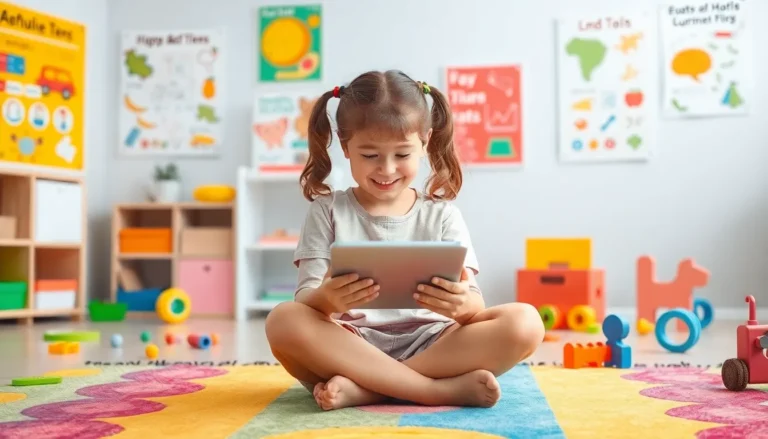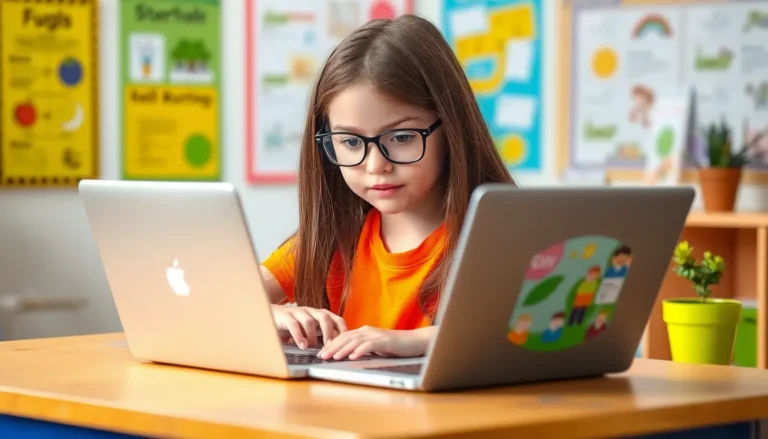Every parent knows that toddlers are tiny bundles of energy, curiosity, and creativity. What if there was a way to harness that energy into something beautiful? Enter process art for toddlers—a magical realm where the journey is just as important as the destination. Forget about perfecting a masterpiece; it’s all about exploration and self-expression.
Imagine a world where splashes of paint and scribbles on paper are celebrated, not critiqued. Process art invites little ones to dive headfirst into creativity, encouraging them to experiment without fear. It’s not just fun; it’s an essential part of their development. So grab those paintbrushes and let the mess begin! Your toddler’s next great adventure awaits, and it might just turn your living room into a colorful gallery.
Table of Contents
ToggleWhat Is Process Art for Toddlers?
Process art for toddlers focuses on the experience of creating rather than the final product. This approach emphasizes exploration, allowing children to engage with materials freely. Art activities may include painting, collage, or sculpting, and the results reflect their unique perspectives.
Creativity thrives in a judgment-free environment. Toddlers explore various textures, colors, and shapes, fostering cognitive development. Observing how they interact with art materials reveals their thought processes and problem-solving skills.
Materials used in process art can vary widely. Common items include finger paints, textured papers, and recyclable materials. These resources encourage sensory exploration, helping toddlers understand the world around them. Messiness often accompanies these activities, but it serves as a vital component of the creative process.
Encouraging open-ended activities allows toddlers to express emotions and ideas. Questions about their creations promote conversation and critical thinking. For example, asking “What colors did you use?” or “How did you make that shape?” fosters engagement and discussion.
Parents can support process art at home by providing accessible art supplies and a designated space for creativity. Setting up a specific area for art encourages self-directed play. It’s important for parents to join in, showing that creativity is valuable and fun.
Ultimately, process art cultivates a love for creativity in toddlers. Instead of focusing on the end result, the emphasis lies on the joy of making art. By embracing this approach, caregivers help nurture budding artists and their imaginations.
Benefits of Process Art

Process art fosters multiple developmental benefits for toddlers. Emphasis on exploration and open-ended experiences cultivates various skills.
Encourages Creativity
Creativity thrives in an unrestricted environment. Toddlers unleash their imagination while experimenting with diverse materials. Engaging with items like paints, clay, and natural elements inspires unique expressions. They make choices that reflect their thoughts and feelings, encouraging individuality. When unrestricted by specific guidelines or outcomes, children embrace their creativity. This freedom empowers them to explore various artistic avenues, resulting in a richer creative experience.
Develops Fine Motor Skills
Fine motor skills play a crucial role in toddlers’ development. Activities such as pouring paint, using brushes, or gluing materials enhance hand-eye coordination. Grasping different tools and manipulating objects strengthens small hand muscles. Progressing through various art projects builds dexterity and control. These essential skills benefit their daily tasks, from buttoning shirts to writing letters. Process art supports the natural development of these skills by making learning enjoyable and engaging.
Different Types of Process Art Activities
Engaging toddlers in various types of process art activities enhances their creativity and self-expression. Below are some exciting options to explore.
Painting Without Brushes
Toddlers can use fingers, sponges, and natural objects for painting, offering a sensory-rich experience. Using finger paints allows them to connect tactile sensations with colors and shapes. Different tools like leaves and sticks create unique textures and patterns. Presenting this art form encourages exploration and invites spontaneous creativity. Parents can provide large sheets of paper or a sturdy canvas, establishing a space for unrestricted artistic expression. Cleanup might be messy, but the joy of discovery outweighs any challenges.
Nature-Inspired Art
Natural materials inspire creativity and connect toddlers to their environment. Twigs, leaves, and flowers become tools for creating art, sparking curiosity and imagination. Collecting items during a nature walk provides an exciting learning experience. Glue and paper serve as a base for toddlers to design their masterpieces. Parents can encourage exploration by discussing colors, shapes, and textures found in nature. This activity fosters appreciation for the outdoors, leading to a deeper understanding of the world around them.
Tips for Implementing Process Art
Creating a supportive environment enhances the process art experience for toddlers.
Creating a Safe Space
Designating a specific area for art ensures freedom in exploration. This space should be easily cleaned, allowing toddlers to engage in messy activities without concern. Soft flooring or mats can cushion falls and prevent injuries. Establishing boundaries ensures that children feel secure while exploring different materials. Parents can rotate supplies to maintain interest and inspiration. An inviting atmosphere fosters creativity and reduces distractions, encouraging focus.
Providing the Right Materials
Selecting diverse materials sparks curiosity in toddlers. Finger paints, textured papers, and recyclable items inspire exploration and experimentation. Include safe and non-toxic options to ensure well-being during activities. Mixing colors and experimenting with different textures enriches the creative experience. Items like brushes, cotton swabs, or natural objects offer various ways to create. Creating a well-stocked art station promotes independence, allowing toddlers to select their materials. Regularly introducing new items keeps their artistic journey exciting and fresh.
Challenges and Solutions
Process art for toddlers presents several challenges, yet solutions exist. Messy play often intimidates parents. To address this concern, setting up a designated art area simplifies cleanup and protects living spaces.
Another challenge involves toddlers’ short attention spans. Engaging activities capture their focus better. Rotating art supplies frequently sustains their interest and fosters creativity. Diverse materials encourage experimentation, helping toddlers remain engaged longer.
Parents sometimes worry about providing appropriate, safe materials. Choosing non-toxic, age-appropriate supplies ensures safety during exploration. A well-stocked art station caters to different interests and sparks curiosity.
Some children display hesitance in trying new materials. Encouraging open-ended exploration promotes confidence. Allowing toddlers to take the lead empowers them, making art-making a joyful experience.
Another obstacle is bridging the gap between guided and independent creation. Parents can facilitate discovery while allowing freedom. By asking open-ended questions, they promote critical thinking without stifling creativity.
Maintaining a balance between structure and free play proves essential. Establishing clear boundaries gives toddlers a sense of security, allowing creativity to flourish.
With these challenges tackled, process art becomes an enriching experience. Prioritizing exploration, safety, and encouragement reinforces toddlers’ love for creativity, resulting in vibrant artistic expression.
Embracing process art for toddlers opens a world of creativity and exploration. It nurtures their natural curiosity while fostering essential developmental skills. Parents can transform their homes into vibrant spaces that celebrate artistic expression without the pressure of perfection.
By allowing toddlers to experiment with various materials and techniques, they gain confidence and independence in their creative journeys. The focus on the process rather than the product empowers children to express themselves freely and develop critical thinking skills.
Ultimately, process art provides an enriching experience that not only enhances creativity but also strengthens the parent-child bond through shared artistic adventures. Encouraging this form of expression is a wonderful way to support toddlers in their growth and development.



